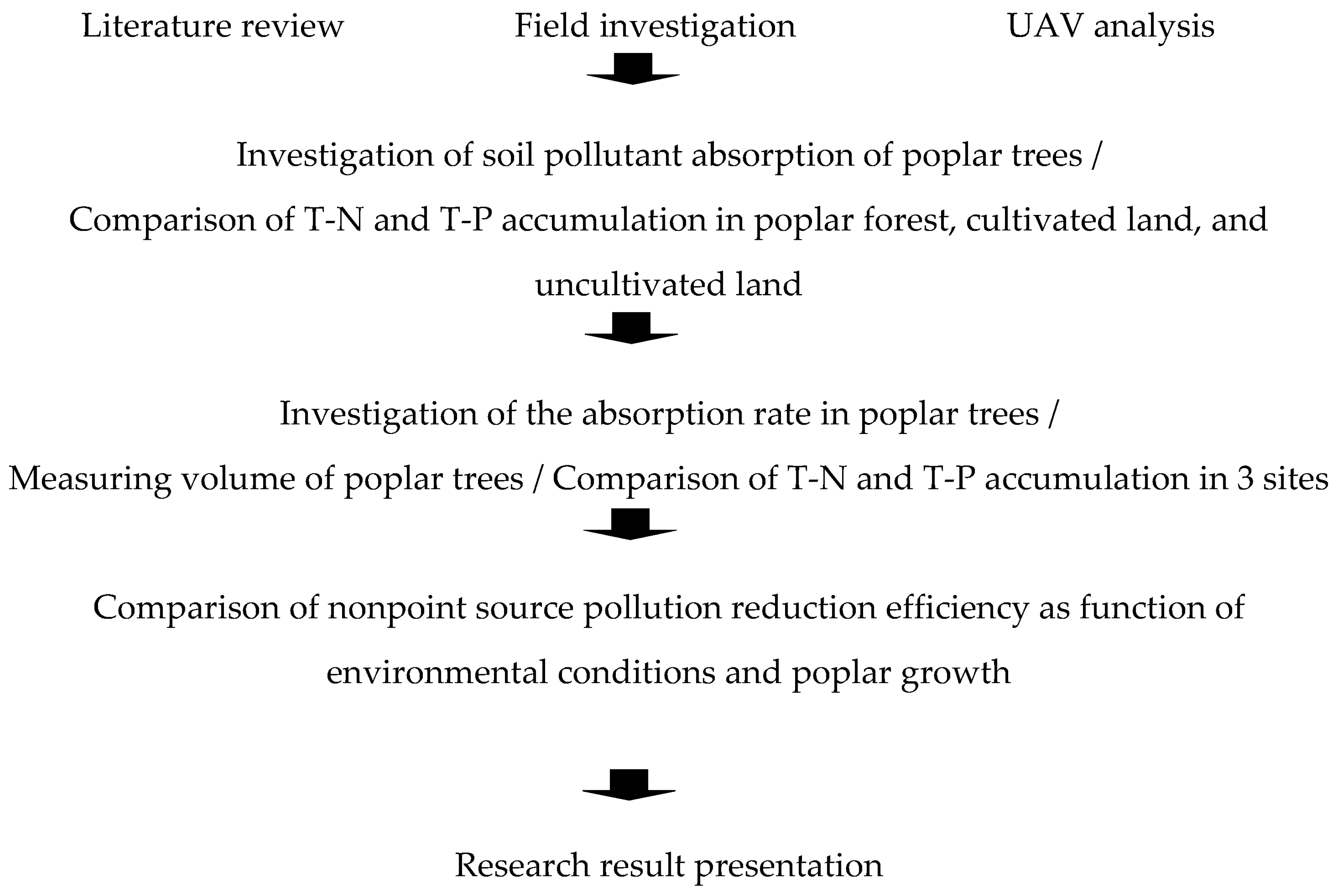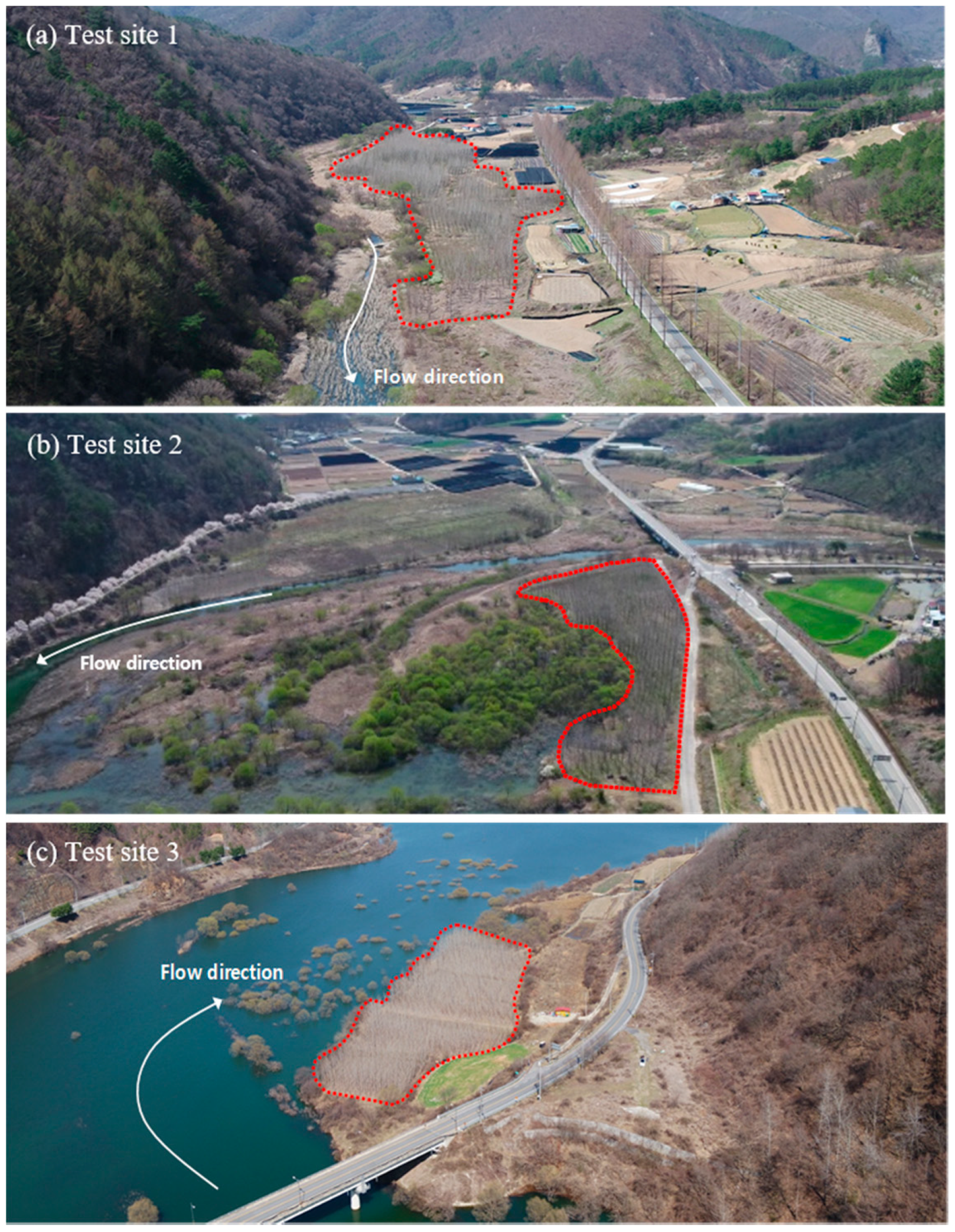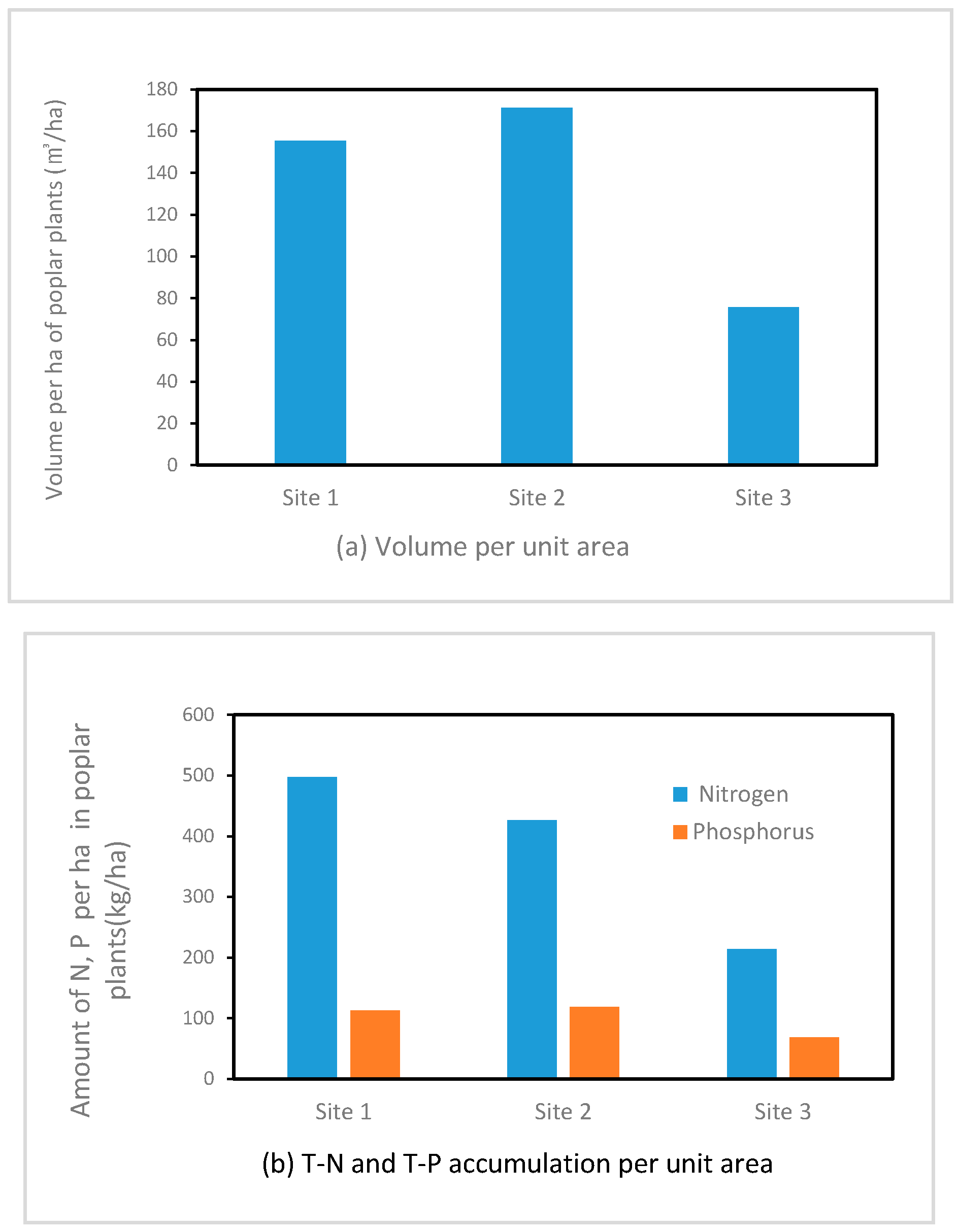Analysis of Environmental Purification Effect of Riparian Forest with Poplar Trees for Ecological Watershed Management: A Case Study in the Floodplain of the Dam Reservoir in Korea
Abstract
1. Introduction
- First, does a riparian forest have a different rate of removal of nitrogen and phosphorus from the soil when compared to other areas?
- Second, does poplar tree growth affect the accumulation rate of nitrogen and phosphorous in the trees?
- Third, are there differences in the growth rate of riparian forests and in the removal of nitrogen and phosphorous from soils depending on the environmental conditions?
2. Materials and Methods
2.1. Study Scope and Area
- ①
- Test site 1: 63-1, Unbong-ri, Jucheon-myeon, Jinan-gun
- ②
- Test site 2: 570-44, Wolpyeong-ri, Jeongcheon-myeon, Jinan-gun
- ③
- Test site 3: 778-1, Galhyeon-ri, Sangjeon-myeon, Jinan-gun
2.2. Planting Poplar for Test
2.3. Research Method
3. Results
3.1. Status of Test Sites
3.2. Soil Analysis of Test Sites
3.2.1. T-N and T-P Content in the Soil of Each Test Site
3.2.2. Comparison of Mean T-N and T-P Values in Soils
3.2.3. Significance of T-N and T-P in the Soils of Riparian Forests
3.3. T-N and T-P Content in Poplar Biomass
3.3.1. Poplar Volume and T-N and T-P Content in Plant Bodies of Each Site
3.3.2. Comparison of Volume Per Unit Area and T-N and T-P Accumulation in Poplars
3.3.3. Differences in Accumulation Rate by Poplar Plant Part
4. Discussion
5. Conclusions
- T-N and T-P values obtained from soil samples from 36 points in riparian forests established over five years ago and the surrounding areas showed normality. The T-N and T-P content of riparian poplar forests were 0.064% and 0.036%, respectively, whereas those of non-riparian forests were 0.147% and 0.101%, respectively. These differences were shown to be significant using a t-test (T-N: p < 0.009, T-P: p < 0.000). Furthermore, the difference in T-N and T-P content was also significant between poplar riparian forests and cultivated land, which were 0.174% and 0.103%, respectively. The T-N concentration in uncultivated land was 0.104%, which did not show a significant difference (p > 0.113) when compared to riparian forests. The potential cause of the significant difference of the T-N value in uncultivated land could be found in the crops grown before the land became ‘uncultivated’, the length of time the land remained uncultivated, and the cultivation method. The T-P concentration was 0.095%, and the difference was significant (p < 0.006). This result may be due to the absorption of nitrogen and phosphorous in the soil through the roots of the poplar trees.
- The total poplar tree volume of the riparian forests was 466.46 m2 at site 1, 171.34 m2 at site 2, and 75.76 m2 at site 3. The T-N and T-P accumulation per unit area was greatest in site 1 at 497.75 and 112.73 kg/ha. The greater the volume of poplar trees per unit area, the greater the accumulation of T-N and T-P in the trees, and the lower the T-N and T-P content of the soil. The removal of T-N and T-P in the soil is expected to increase in the future when the volume increases thanks to the more active absorption of nitrogen and phosphorous, which required for poplar growth. Furthermore, when the T-N and T-P content of the branch, stem, and leaf parts of poplars were measured, the mean T-N accumulation was 0.186% for the stem, 0.687% for the branch, and 1.968% for the leaf. In addition, the mean T-P was 0.661% for the stem, 0.144% for the branch, and 0.364% for the leaf. As this investigation was carried out in October, nitrogen and phosphorous content in the leaves would have decreased before the leaves fall, and some nitrogen from the falling leaves would have been stored in the branches.
- The average height of the poplar trees in site 3 was 9.8 m, the mean diameter at breast height was 8.2 cm, and the total volume was the lowest among the three sites. Furthermore, T-N and T-P accumulation per unit area (ha) in site 1 were 56% and 68% of the average values, respectively; both values were lower than in sites 2 and 3. This is potentially due to the difference in the crops cultivated before the poplars were planted, the soil quality, and the terrain. Therefore, if these factors are sufficiently accounted for when creating riparian forests, they may promote the growth and purification ability of the plants.
Supplementary Materials
Supplementary File 1Author Contributions
Funding
Conflicts of Interest
References
- Mendlik, T.; Gobiet, A. Selecting climate simulations for impact studies based on multivariate patterns of climate change. Clim. Chang. 2016, 135, 381–393. [Google Scholar] [CrossRef] [PubMed]
- Ribaudo, M.; Jorge, D.; LeRoy, H.; Michael, L.; Roberto, M.; James, W. Nitrogen in Agricultural Systems: Implications for Conservation Policy. USDA-ERS Economic Research Report No. 127. 2011. Available online: https://papers.ssrn.com/sol3/papers.cfm?abstract_id=2115532 (accessed on 7 May 2020).
- Davidson, E.A.; David, M.B.; Galloway, J.N.; Goodale, C.L.; Haeuber, R.; Harrison, J.A.; Peel, J.L. Excess nitrogen in the US environment: Trends, risks, and solutions. Issues Ecol. 2011, 15. [Google Scholar]
- Su, X.; Wang, H.; Zhang, Y. Health risk assessment of nitrate contamination in groundwater: A case study of an agricultural area in Northeast China. Water Resour. Manag. 2013, 27, 3025–3034. [Google Scholar] [CrossRef]
- Galloway, J.N.; Schlesinger, W.H.; Levy, H.; Michaels, A.; Schnoor, J.L. Nitrogen fixation: Anthropogenic enhancement-environmental response. Glob. Biogeochem. Cycles 1995, 9, 235–252. [Google Scholar] [CrossRef]
- Howarth, R.W.; Billen, G.; Swaney, D.; Townsend, A.; Jaworski, N.; Lajtha, K.; Downing, J.A.; Elmgren, R.; Caraco, N.; Jordan, T.; et al. Regional nitrogen budgets and riverine N & P fluxes for the drainages to the North Atlantic Ocean: Natural and human influences. In Nitrogen Cycling in the North Atlantic Ocean and Its Watersheds; Springer: Dordrecht, The Netherlands, 1996; Volume 35, pp. 75–139. [Google Scholar]
- Parris, K. Impact of agriculture on water pollution in OECD countries: Recent trends and future prospects. Int. J. Water Resour. 2011, 27, 33–52. [Google Scholar] [CrossRef]
- OECD. Environmental performance of agriculture—Indicators. OECD Agric. Stat. (Database) 2020. [Google Scholar] [CrossRef]
- Dwire, K.A.; Lowrance, R.R. Riparian ecosystems and buffers-multiscale structure, function, and management: Introduction. J. Am. Water Resour. Assoc. 2006, 42, 1–4. [Google Scholar] [CrossRef]
- Jobin, B.; Belanger, L.; Boutin, C.; Maisonneuve, C. Conservation value of agricultural riparian strips in the Boyer River watershed, Quebec (Canada). Agric. Ecosyst. Environ 2004, 103, 413–423. [Google Scholar] [CrossRef]
- Browder, G.; Ozment, S.; Rehberger Bescos, I.; Gartner, T.; Lange, G.M. Integrating Green and Gray: Creating Next Generation Infrastructure; World Bank and World Resources Institute: Washington, DC, USA, 2019; Available online: https://openknowledge.worldbank.org/handle/10986/31430 (accessed on 3 May 2020).
- Haase, D. Urban wetlands and Riparian forests as a nature-based solution for climate change adaptation in cities and their surroundings. In Nature-Based Solutions to Climate Change Adaptation in Urban Areas; Springer: Cham, Switzerland, 2017; pp. 111–121. [Google Scholar]
- Dix, M.E.; Klopfenstein, N.B.; Zhang, J.W.; Workman, S.W.; Kim, M.S. Potential use of Populus for phytoremediation of environmental pollution in riparian zones. USDA For. Serv. Gen. Tech. Rep. 1997, 297, 206–211. [Google Scholar]
- Ebbs, S.D.; Lasat, M.N.; Brady, D.J.; Cornish, J.; Gorden, R.; Kochian, L.V. Phytoextraction of cadmium and zinc from a contaminated soil. J. Environ. Qual. 1997, 26, 1424–1430. [Google Scholar] [CrossRef]
- Yeo, J.K.; Woo, K.S.; Koo, Y.B.; Kim, Y.S. Growth performance and adaptability of Three-year-old poplar and willow clones in a riparian area. J. Korean Soc. Environ. Restor. Tech. 2007, 10, 40–50. (In Korean) [Google Scholar]
- FAO. Poplars and willows in wood production and land use. FAO For. Ser. 1980, 10, 328. [Google Scholar]
- Dickmann, E.I.; Isebrands, J.G.; Eckenwalder, J.E.; Richardson, R. An overview of the genus Populus. In Poplar Culture in North America Part A; NRC Research Press: Ottawa, ON, Canada, 2001; p. 397. [Google Scholar]
- Isebrands, J.G.; Karnosky, D.F. Environmental benefits of poplar culture. In Poplar Culture in North America Part A; NRC Research Press: Ottawa, ON, Canada, 2001; pp. 207–218. [Google Scholar]
- Westphal, L.M.; Isebrands, J.G. Phytoremediation of Chicago’s brownfields-consideration of ecological approaches and social issues. In Brownfields 2001 Proceedings; United States Department of Agriculture: Chicago, IL, USA, 2001. [Google Scholar]
- Liu, Y.; Yang, W.; Wang, X. GIS-based integration of SWAT and REMM for estimating water quality benefits of riparian buffers in agricultural watersheds. Trans. ASABE 2007, 50, 1549–1563. [Google Scholar] [CrossRef]
- Inamdar, S.P.; Lowrance, R.R.; Altier, L.S.; Williams, R.G.; Hubbard, R.K. Riparian Ecosystem Management Model (REMM): II. Testing of the water quality and nutrient cycling component for a coastal plain riparian system. Trans. ASAE 1999, 42, 1691. [Google Scholar] [CrossRef]
- Lowrance, R.; Altier, L.S.; Williams, R.G.; Inamdar, S.P.; Sheridan, J.M.; Bosch, D.D.; Hubbard, R.K.; Thomas, D.L. REMM: The riparian ecosystem management model. J. Soil Water Conserv. 2000, 55, 27–34. [Google Scholar]
- Ryu, J.; Cho, J.; Kim, I.J.; Mun, Y.; Moon, J.P.; Kim, N.W.; Kim, S.J.; Lim, K.J. Enhancement of SWAT-REMM to simulate reduction of total nitrogen with riparian buffer. Trans. ASABE 2011, 54, 1791–1798. [Google Scholar] [CrossRef]
- Choi, Y.H.; Ryu, J.C.; Hwang, H.S.; Kum, D.H.; Park, Y.S.; Jung, Y.H.; Choi, J.D.; Lim, K.J. Analysis of pollutant load reduction efficiency with Riparian buffer system Using the SWAT-REMM. J. Korean Soc. Water Environ. 2015, 31, 166–180. (In Korean) [Google Scholar] [CrossRef]
- Yeo, J.K.; Lee, W.W.; Koo, Y.B.; Woo, K.S.; Byun, J.K. Nitrogen Storage Potential in Aboveground Biomass of Three-year-old Poplar Clones in a Riparian Area. J. Agric. Life Sci. 2010, 44, 15–21. (In Korean) [Google Scholar]
- Weather Go. Available online: http://www.kma.go.kr (accessed on 2 June 2020). (In Korean).
- My Water: K-Water. Available online: http://www.water.or.kr (accessed on 2 June 2020). (In Korean).
- Forest Geospatial Information Services. Available online: http://map.forest.go.kr (accessed on 2 June 2020). (In Korean).
- Korea Forest Service. Forest Volume, Biomass and Harvest Manual. 2017. Available online: https://www.montrealprocess.org/documents/publications/general/2014/KoreaNationalReportForSFM2014.pdf (accessed on 2 June 2020).





| Site 1 | Site 2 | Site 3 | |
|---|---|---|---|
| ●Species | Populus deltoides Populus deltoides × P. nigra | Populus deltoides Populus deltoides × P. nigra | Populus deltoides Populus deltoides × P. nigra |
| ●Planted area (m2) | 30,000 | 10,000 | 10,000 |
| ●Planted quantity | 7000 | 2500 | 2500 |
| Point of Investigation | Site 1 | Site 2 | Site 3 | ||||||||||
|---|---|---|---|---|---|---|---|---|---|---|---|---|---|
| T-N (%) | T-P (%) | T-N (%) | T-P (%) | T-N (%) | T-P (%) | ||||||||
| Measure | Mean | Measure | Mean | Measure | Mean | Measure | Mean | Measure | Mean | Measure | Mean | ||
| Poplar forest | 1 | 0.047 | 0.030 | 0.001 | 0.005 | 0.002 | 0.079 | 0.001 | 0.031 | 0.160 | 0.082 | 0.092 | 0.073 |
| 2 | 0.035 | 0.008 | 0.166 | 0.051 | 0.059 | 0.073 | |||||||
| 3 | 0.007 | 0.001 | 0.074 | 0.017 | 0.047 | 0.062 | |||||||
| 4 | 0.030 | 0.008 | 0.072 | 0.055 | 0.063 | 0.064 | |||||||
| Uncultivated | 5 | 0.130 | 0.133 | 0.160 | 0.119 | 0.032 | 0.076 | 0.140 | 0.069 | 0.190 | 0.101 | 0.180 | 0.099 |
| 6 | 0.120 | 0.101 | 0.115 | 0.012 | 0.052 | 0.055 | |||||||
| 7 | 0.150 | 0.096 | 0.081 | 0.055 | 0.062 | 0.062 | |||||||
| Cultivated | 8 | 0.230 | 0.220 | 0.152 | 0.095 | 0.320 | 0.134 | 0.063 | 0.107 | 0.370 | 0.167 | 0.110 | 0.108 |
| 9 | 0.330 | 0.045 | 0.043 | 0.069 | 0.089 | 0.077 | |||||||
| 10 | 0.150 | 0.020 | 0.058 | 0.114 | 0.097 | 0.105 | |||||||
| 11 | 0.190 | 0.119 | 0.048 | 0.128 | 0.138 | 0.125 | |||||||
| 12 | 0.200 | 0.141 | 0.200 | 0.160 | 0.140 | 0.123 | |||||||
| Site 1 (%) | Site 2 (%) | Site 3 (%) | Mean (%) | |||||||||
|---|---|---|---|---|---|---|---|---|---|---|---|---|
| a | b | c | a | b | c | a | b | c | a | b | c | |
| T-N | 0.030 | 0.133 | 0.220 | 0.079 | 0.076 | 0.134 | 0.082 | 0.101 | 0.167 | 0.064 | 0.104 | 0.174 |
| T-P | 0.005 | 0.119 | 0.095 | 0.031 | 0.069 | 0.107 | 0.073 | 0.099 | 0.108 | 0.036 | 0.096 | 0.103 |
| N | Mean | SD | Variance | Skewness | Kurtosis | |
|---|---|---|---|---|---|---|
| T-N | 36 | 0.119 | 0.090 | 0.008 | 1.17 | 1.08 |
| T-P | 36 | 0.079 | 0.051 | 0.003 | 0.089 | −0.978 |
| Group | N | Mean | SD | t | p-Value | |
|---|---|---|---|---|---|---|
| T-N | A | 12 | 0.067 | 0.048 | −2.779 | 0.009 |
| B | 24 | 0.147 | 0.093 | |||
| T-P | A | 12 | 0.036 | 0.033 | −4.343 | 0.000 |
| B | 24 | 0.101 | 0.046 |
| Group | N | Mean | SD | t | p-Value | |
|---|---|---|---|---|---|---|
| T-N | a | 12 | 0.067 | 0.048 | −1.664 | 0.113 |
| b | 9 | 0.104 | 0.051 | |||
| a | 12 | 0.067 | 0.048 | −3.259 | 0.003 | |
| c | 15 | 0.174 | 0.104 | |||
| T-P | a | 12 | 0.036 | 0.033 | −3.069 | 0.006 |
| b | 9 | 0.095 | 0.055 | |||
| a | 12 | 0.036 | 0.033 | −4.654 | 0.000 | |
| c | 15 | 0.103 | 0.040 |
| Site | Planted Area (m2) | Sample | Number of Trees | Height (m) | DBH (cm) | |
|---|---|---|---|---|---|---|
| Number | Area (m2) | |||||
| Site 1 | 30,000 | 3 | 600 | 118 | 13.6 ± 1.44 (11~16) | 11.3 ± 3.49 (6~20) |
| Site 2 | 10,000 | 2 | 400 | 72 | 13.8 ± 0.97 (12~15) | 12.6 ± 3.88 (6~22) |
| Site 3 | 10,000 | 2 | 400 | 100 | 9.8 ± 0.82 (9~12) | 8.2 ± 1.83 (6~14) |
| Site | Area (ha) | Part | Volume (m3) (1) | T-N Ratio (%) | T-P Ratio (%) | N (kg) (2) | P (kg) (2) |
|---|---|---|---|---|---|---|---|
| Site 1 | 3.00 | Total | 466.40 | 1493.25 | 338.18 | ||
| Stem | 395.25 | 0.24 | 0.06 | 967.05 | 235.83 | ||
| Branch | 63.24 | 0.53 | 0.11 | 333.06 | 68.09 | ||
| Leaf | 7.91 | 2.44 | 0.43 | 193.15 | 34.26 | ||
| Site 2 | 1.00 | Total | 171.34 | 426.60 | 118.34 | ||
| Stem | 145.20 | 0.14 | 0.05 | 196.02 | 70.42 | ||
| Branch | 23.23 | 0.78 | 0.17 | 180.05 | 38.33 | ||
| Leaf | 2.90 | 1.74 | 0.33 | 50.53 | 9.58 | ||
| Site 3 | 1.00 | Total | 75.76 | 214.43 | 68.18 | ||
| Stem | 64.20 | 0.18 | 0.07 | 114.28 | 47.51 | ||
| Branch | 10.27 | 0.76 | 0.16 | 78.07 | 16.44 | ||
| Leaf | 1.28 | 1.72 | 0.33 | 22.08 | 4.24 |
| Sample N | T-N (kg/m3) | T-P (kg/ m3) | |||||||
|---|---|---|---|---|---|---|---|---|---|
| Mean | SD. | Min. | Max. | Mean | SD. | Min. | Max. | ||
| Stem | 7 | 1.94 | 1.55 | 0.76 | 5.10 | 0.61 | 0.31 | 0.30 | 1.10 |
| Branch | 7 | 6.64 | 1.72 | 4.10 | 8.90 | 1.39 | 0.32 | 0.93 | 1.70 |
| Leaf | 7 | 20.4 | 5.40 | 13.10 | 28.10 | 3.74 | 1.41 | 2.20 | 6.30 |
© 2020 by the authors. Licensee MDPI, Basel, Switzerland. This article is an open access article distributed under the terms and conditions of the Creative Commons Attribution (CC BY) license (http://creativecommons.org/licenses/by/4.0/).
Share and Cite
Bahn, G.-S.; An, B.-C. Analysis of Environmental Purification Effect of Riparian Forest with Poplar Trees for Ecological Watershed Management: A Case Study in the Floodplain of the Dam Reservoir in Korea. Sustainability 2020, 12, 6871. https://doi.org/10.3390/su12176871
Bahn G-S, An B-C. Analysis of Environmental Purification Effect of Riparian Forest with Poplar Trees for Ecological Watershed Management: A Case Study in the Floodplain of the Dam Reservoir in Korea. Sustainability. 2020; 12(17):6871. https://doi.org/10.3390/su12176871
Chicago/Turabian StyleBahn, Gwon-Soo, and Byung-Chul An. 2020. "Analysis of Environmental Purification Effect of Riparian Forest with Poplar Trees for Ecological Watershed Management: A Case Study in the Floodplain of the Dam Reservoir in Korea" Sustainability 12, no. 17: 6871. https://doi.org/10.3390/su12176871
APA StyleBahn, G.-S., & An, B.-C. (2020). Analysis of Environmental Purification Effect of Riparian Forest with Poplar Trees for Ecological Watershed Management: A Case Study in the Floodplain of the Dam Reservoir in Korea. Sustainability, 12(17), 6871. https://doi.org/10.3390/su12176871






